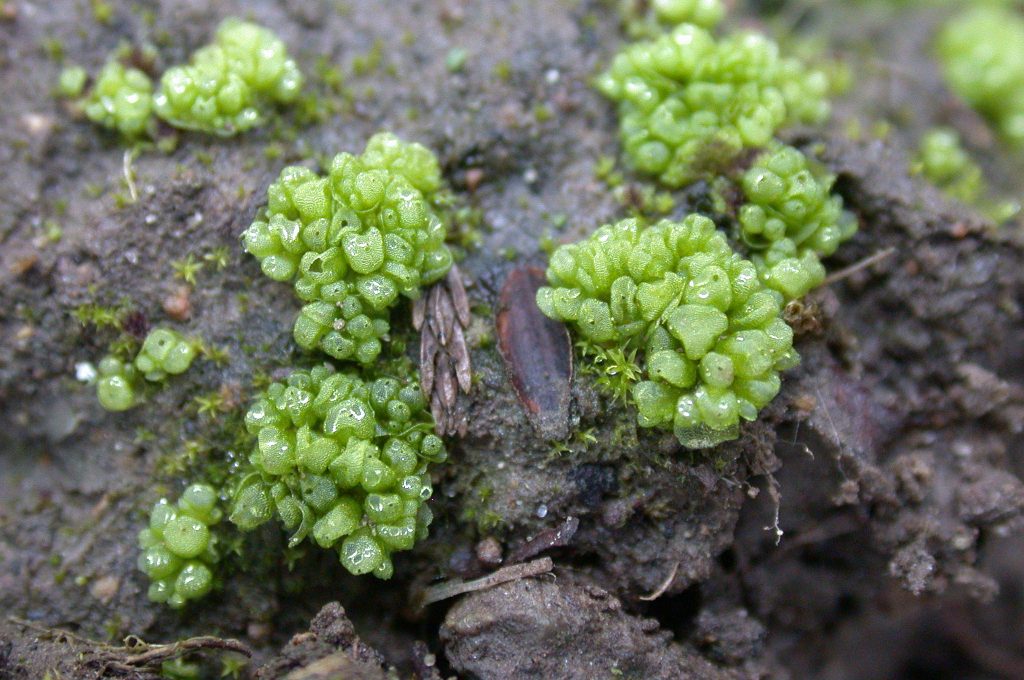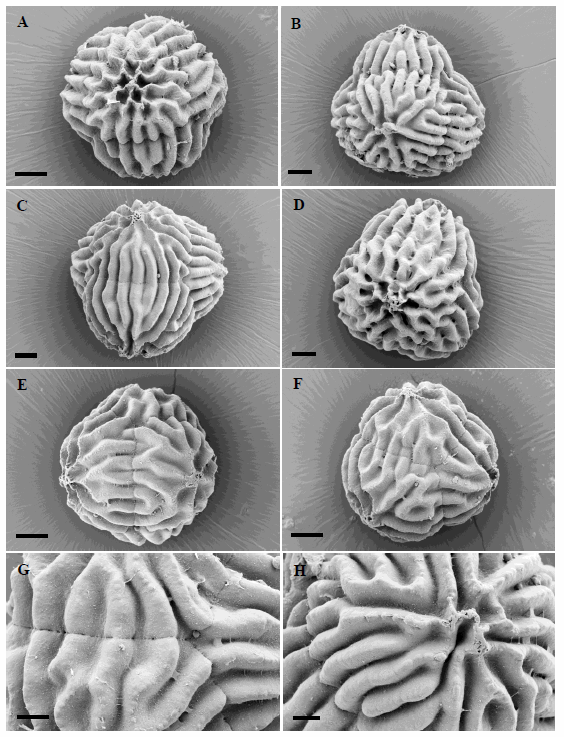The Sphaerocarpales (or “Bottle Liverworts”) form a very distinct group in the complex thalloid liverworts, with ca. 30 species in five genera: originally the group just included Geothallus (monospecific), Sphaerocarpos (8-9 species) and Riella (ca. 20 species), with two more monospecific genera, Austroriella and Monocarpus, added within the last few years. All five genera have very unusual, and highly reduced, thallus morphologies. With the exception of Monocarpus, they also all enclose their sex organs (or gametangia – the antheridia and archegonia) in inflated flask-shaped bottles (as can be seen in the accompanying photograph). This feature sets them apart from all other liverworts. All of them are adapted to extreme habitats, including arable fields, hot arid regions, seasonal lakes and pools, and salt pans.
A worldwide revision of the second largest genus of the group, Sphaerocarpos, is over 100 years old (Haynes 1910); other revisional work focuses on individual geographic areas, including South Africa (Proskauer 1955), North America (Haynes & Howe 1923, Frye & Clark 1937, Schuster 1992, Timme 2003), California (Howe 1899), Europe (Reimers 1936, Müller 1954), and France (Douin 1907). No revisions have been made for large areas including Australia, Asia and South America, and most of the work predates any DNA-based concepts of plant identification or species relationships. Bringing the taxonomy of Sphaerocarpos into the 21st century, Dr Daniela Schill spent 18 months (2007-2009) at RBGE on a Sibbald Trust-funded project to compile a world-wide taxonomic revision of the genus. Two field expeditions fed into the project, with Dr David Long collecting European species in Portugal in April 2007, and Daniela collecting North American species in California in March 2008 (funded by the Peter Davis Expedition Fund).
Daniela’s work is based on morphological and anatomical characters, including spore characters that she observed using Scanning Electron Microscopy (SEM). Her aim has been to produce identification keys to the species, species descriptions, species lists, synonyms, botanical drawings, distribution maps, and ecological, nomenclatural and taxonomical notes. Although the study is not yet published, much of it, including SEM plates for spores from the ca. 9 different species (as seen on the right), is complete.
In parallel, RBGE staff have also been sequencing multiple accessions of all available Sphaerocarpos species, producing data that has helped inform some of Daniela’s taxonomic decisions, and that also allow us to generate a stand-alone phylogeny for the genus.
This research will lead to some taxonomic changes. For example, European Sphaerocarpos texanus plants differ from American S. texanus, both in their DNA sequences and in their spore characters, and so they are likely to be considered a separate species. Furthermore, European Sphaerocarpos michelii material includes three different forms based on spore characters; these are also confirmed by molecular research, and may be recognised at or below the rank of species.
References:
Cargill, D.C. & J. Milne. 2013. A new terrestrial genus and species within the aquatic liverwort family Riellaceae (Sphaerocarpales) from Australia. Polish Botanical Journal 58(1): 71-80.
Douin R. 1907. Les Sphaerocarpus français. Revue Bryologique 34(6): 105-112.
Frye T.C. & L. Clark. 1937. Hepaticae of North America. University of Washington Publications in Biology 6: 105-113.
Haynes C.C. 1910. Sphaerocarpos hians sp. nov., with a revision of the genus and illustrations of the species. Bulletin of the Torrey Botanical Club 37(5): 215-230.
Haynes C.C. & M.A. Howe. 1923. Sphaerocarpales. North American Flora 14: 1-8.
Howe M.A. 1899. The hepaticae and anthocerotes of California. Memoirs of the Torrey Botanical Club 7: 64-70.
Müller K. 1954. Die Lebermoose Europas. In: Rabenhorst’s Kryptogamenflora von Deutschland, Österreich und der Schweiz. 3. Auflage. Volume VI. Part 1. Leipzig, Akademische Verlagsgesellschaft Geest & Portig K.-G., Johnson Reprint Corporation (1971), New York, London.
Proskauer J. 1955. The Sphaerocarpales of South Africa. The Journal of South African Botany 21: 63-75.
Reimers H. 1936. Revision des europäischen Sphaerocarpus-Materials im Berliner Herbar. Hedwigia 76: 153-164.
Schill D.B., L. Miserere & D.G.Long. 2009. Typification of Sphaerocarpos michelii Bellardi, S. terrestris Sm. and Targionia sphaerocarpos Dicks. (Marchantiophyta, Sphaerocarpaceae). Taxon 58(2): 638-640.
Schuster R.M. 1992. Sphaerocarpales. In: The hepaticae and anthocerotae of North America V. Field Museum of Natural History, Chicago: 799-827.
Timme S.L. 2003. Sphaerocarpaceae. In: Bryophyte Flora of North America, Provisional Publication.


